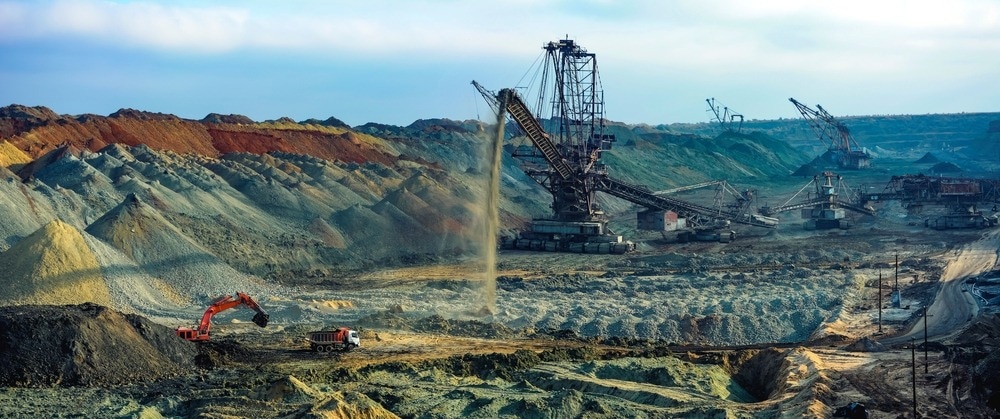
Image Credit: Romeo Rum/Shutterstock.com
Importance of Fragmentation Optimization in Mines
In open-pit mining operations, a larger energy consumption comprises the comminution processes. Therefore, blasting operations for rock fragmentation contribute to improving comminution efficiency, particularly in hard rock mines. Several factors control rock fragmentation pertaining to blasting and drilling design parameters and the rock mass properties.
Optimizing blasting and drilling factors to improve rock fragmentation can improve mine-to-mill productivity, including milling, loading, and transport. The total cost of these operations can also be reduced. Optimization should maximize the crusher feed and minimize the loading times. The improved fragmentation during blasting can significantly influence these requirements.
Fragmentation Optimization Parameters
The fundamentals for a blast design include sufficient flexibility and simpler operation to ensure optimum results in existing operating environments. The factors affecting a blast output are usually categorized into two groups, namely controllable and uncontrollable factors.
Uncontrollable factors are influenced by the in situ formation’s behavior and properties. Understanding the effect of the properties of a rock mass on blasting is necessary for optimum blasting as these properties can show considerable variations over short distances. Rock strength is determined by the force required to fail or break a rock by tension, compression, or shear. Placing the rock under tension can result in breakage while shear placement can create smooth surfaces.
The elastic modulus describes a rock’s rigidity and resistance to external influences. A gas pressure lower than 5% of the modulus enables efficient blasting. Moreover, rock density can also be used to devise accurate powder or energy factors. The blasting efficiency is also affected by the rock porosity. The lower density of porous rocks allows them to absorb energy, causing fragmentation challenges. The variations in the rock properties can be crucial for blasting since it aids in predicting the fragmentation extent within the blasted material.
Controllable factors can be controlled by the blaster and must be chosen to eliminate difficulties caused by uncontrollable factors. The two types of controllable factors comprise: (i) the geometrical factors consisting of the hole diameter and depth, the bench and stemming height, sub-drill depth, and the material spacing and burden; and (ii) the explosive parameters including the explosive types and their properties such as the powder factor.
Blast Optimization Modeling in Copper Mines
Various methods can carry out the optimization of blasting operations. A study applied several blast hole diameters to reduce oversized toes and boulders employing a statistical damage constitutive model and a nonideal detonation model. Another study attempted to predict the distribution of the blasting fragmentation based on the blasting design parameters while utilizing machine learning methods.
In a study by Torres et al., the blasting performance’s numerical analysis was employed to optimize the blasting factors and enhance the hard rock fragmentation in an open-pit copper mine in Brazil. The methodology included data collection, using Blo-Up software to construct a 3D numerical model to optimize the blasting performance, standardization with the historical data, and finally a predictive analysis. The results attained the desired 80% passing size (P80) of 0.55 m.
In 2005, Boliden conducted an optimization study on the fragmentation at its open-cast copper mine, Aitik. The method aimed at optimizing the fragmentation to maximize the bottleneck capacity. Five trial blasts were prepared based on this method. The trial blasts showed an 8% average increase in the throughput, indicating that optimization at Aitik was achievable through finer fragmentation.
A 2017 study reviewed data on fragmentation from 35 open-pit gold and copper mines to compare and identify the causes of variations. It was determined that variability before optimization in P80 was greater than the optimized P80. The cause of this variation was mainly attributed to QA/QC issues, including inadequate drilling control, incorrect stemming material size, and mediocre choice of the blast design factors such as incorrect stemming length, small blast shape, size, and insufficient powder factor.
Another study in 2018 analyzed the size distribution of the muck pile resulting from the blasts at a western US copper mine utilizing the Split-Desktop image analysis software. Five out of eight blasts exhibited an underestimation trend while predicting the mean sizes of the fragments. A modified Kuz-Ram model showed better performance with less than 10% prediction errors within the fines regions.
Future Scope
Overall, the operation costs and productivity at mines can be influenced by comprehending fragmentation variations and enhancing the fragmentations utilizing accurate modeling. An organized methodology and comprehensive audits at mines can be essential to reach the desired productivity levels.
Further improvements in the existing methods can be brought about by improved fragmentation measurements and material tracking, leading to maximized mill throughputs. Models such as the modified Kuz-Ram model can also be employed in blasting over virgin areas but with adequate information on the rock properties.
References and Further Reading
Torres, V.F.N.; Castro, C.; Valencia, M.E.; Figueiredo, J.R.; Silveira, L.G.C. Numerical Modelling of Blasting Fragmentation Optimization in a Copper Mine. Mining 2022, 2, 654-669. https://doi.org/10.3390/mining2040035
Gadikor, Joel, "OPTIMIZATION OF DRILLING AND BLASTING PRACTICES AT A WESTERN US OPEN PIT COPPER MINE" (2018). Graduate Theses & Non-Theses. 168. https://digitalcommons.mtech.edu/grad_rsch/168
Esen, S., Evaluating the Fragmentation Data from Copper and Gold Mines, International Society of Explosives Engineers, 2017, https://assets.website-files.com/5df8418240a1a9ddae69e20f/5df86fc23f85f7bedc3f3358_paper_1.pdf
Bergman, P., Optimisation of Fragmentation and Comminution at Boliden Mineral, Aitik Operation, Lulea University of Technology, https://www.diva-portal.org/smash/get/diva2:989832/FULLTEXT01.pdf
Amiel, A., Blast fragmentation optimization at Tarkwa Gold Mine using 6 Sigma methodologies, The Journal of The Southern African Institute of Mining and Metallurgy, 2008, Vol. 108, http://www.scielo.org.za/pdf/jsaimm/v108n11/08.pdf
Disclaimer: The views expressed here are those of the author expressed in their private capacity and do not necessarily represent the views of AZoM.com Limited T/A AZoNetwork the owner and operator of this website. This disclaimer forms part of the Terms and conditions of use of this website.